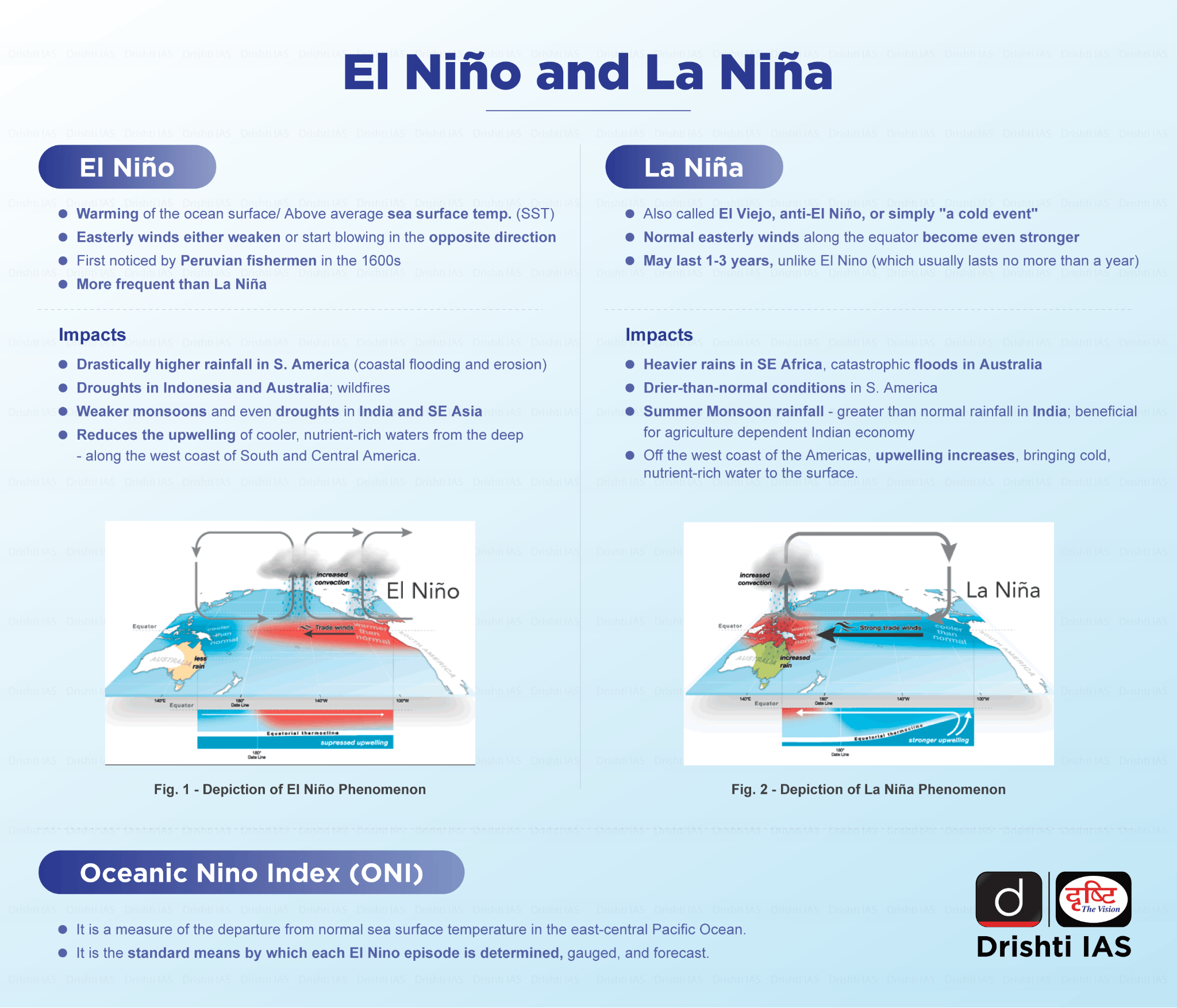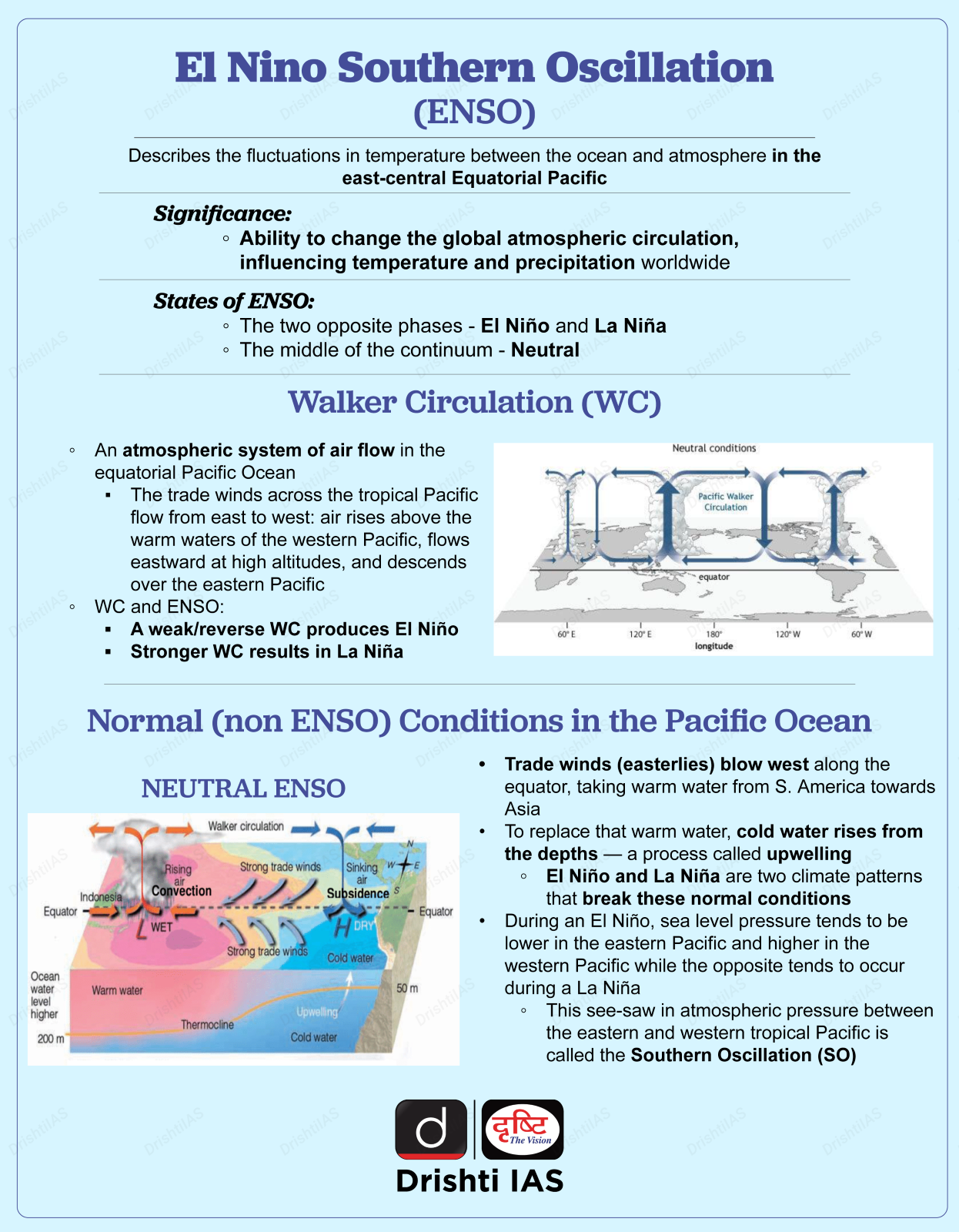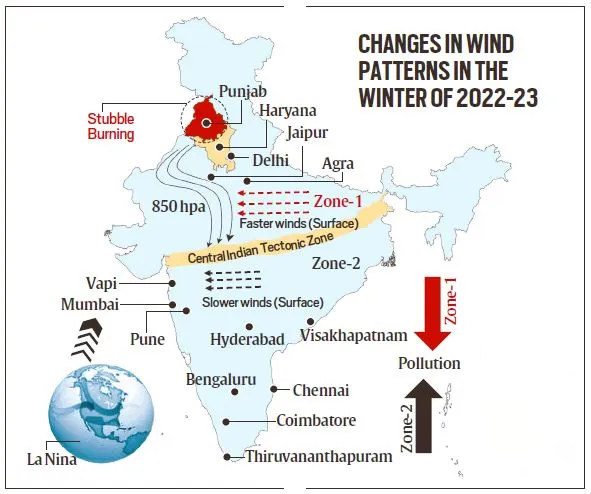Geography
La Nina Links with Air Quality
- 22 Feb 2024
- 8 min read
For Prelims: La Nina Links with Air Quality, El Nino and La Nina events, PM2.5, Gangetic plains.
For Mains: La Nina Links with Air Quality, Salient features of the world’s physical geography.
Why in News?
Recently, a new study has been published by researchers at the Pune-based Indian Institute of Tropical Meteorology and the Bengaluru-based National Institute of Advanced Studies, suggesting that even air quality in India could be influenced by El Nino and La Nina events.
- The study has suggested that the unusual air quality in some Indian cities in the winter of 2022 could be attributed to the record-breaking spell of La Nina prevailing at that time.
What are the Key Findings of the Study?
- Link between Pollution and Winter Months in India:
- During October to January, northern Indian cities, like Delhi, typically have high levels of PM2.5 due to various meteorological factors and pollution transport from regions like Punjab and Haryana.
- The western and southern parts of the country have always had relatively lower levels of pollution, because of their proximity to oceans.
- The winter of 2022, however, showed a significant deviation from this normal.
- Northern Indian cities, including Delhi, were cleaner than usual, while cities in the west and the south, like Mumbai, Bengaluru and Chennai, experienced worse-than-usual air quality.
- Anomalous Behaviour in Winter 2022:
- PM2.5 concentrations in Ghaziabad and Noida reduced significantly, while Delhi saw a slight reduction. In contrast, Mumbai and Bengaluru experienced rises in PM2.5 levels.
- Northern Indian cities had cleaner air than western and southern cities.
- PM2.5 concentrations in Ghaziabad and Noida reduced significantly, while Delhi saw a slight reduction. In contrast, Mumbai and Bengaluru experienced rises in PM2.5 levels.
- Factors Causing Anomaly:
- The most crucial factor in explaining the anomaly of winter 2022 was a change in the normal wind direction.
- During winter, the wind usually blows in the northwesterly direction. For example, from Punjab towards Delhi and further into the Gangetic plains.
- It is a reason for transporting agricultural waste pollutants from Punjab and Haryana into Delhi.
- In the winter of 2022, however, the wind circulation was in the north-south direction.
- The pollutants being carried from Punjab and Haryana bypassed Delhi and surrounding areas and flew over Rajasthan and Gujarat to southern regions.
- La Nina's Influence:
- Extended La Nina persisted for an unusually long three years by the winter of 2022, impacting wind patterns.
- The three consecutive years of La Niña conditions (2020-23) — a rare “Triple-Dip” phenomenon — had widespread impacts on the ocean and climate across the globe.
- Not all La Nina events might produce noticeable changes in wind circulation over India.
- The 2022 event is particularly strong. And the impact on air circulation became evident only in the third year of La Nina. So, there may be an accumulative effect.
- The study suggests an unclear impact of El Nino on air quality in India.
- Extended La Nina persisted for an unusually long three years by the winter of 2022, impacting wind patterns.
 |
 |
Indian Institute of Tropical Meteorology (IITM)
- IITM is a scientific institution based in Pune, Maharashtra. It specializes in expanding research related to tropical meteorology, with a special focus on the tropical Indian Ocean.
- Key areas of study include monsoon meteorology and air-sea interactions in the South Asian climate.
- IITM operates as an autonomous institute under the Ministry of Earth Sciences, Government of India.
National Institute of Advanced Studies (NIAS)
- NIAS is an autonomous research institution located in Bengaluru, India. It was established in 1988 with the vision and initiative of the late Mr. J.R.D. Tata.
- The institute aims to nurture a broad base of scholars, managers, and leaders who can address complex societal challenges through interdisciplinary approaches.
- NIAS conducts advanced multidisciplinary research in various fields, including humanities, social sciences, natural sciences, engineering, and conflict and security studies.
Conclusion
- La Nina's influence on air quality in India during winter 2022 highlights the importance of understanding global climate patterns in local environmental conditions.
- Further research is needed to elucidate the complex interactions between climate phenomena and air quality in India.
UPSC Civil Services Examination Previous Year Question (PYQ)
Prelims
Q. With reference to ‘Indian Ocean Dipole (IOD)’ sometimes mentioned in the news while forecasting Indian monsoon, which of the following statements is/are correct? (2017)
- IOD phenomenon is characterised by a difference in sea surface temperature between tropical Western Indian Ocean and tropical Eastern Pacific Ocean.
- An IOD phenomenon can influence an El Nino’s impact on the monsoon.
Select the correct answer using the code given below:
(a) 1 only
(b) 2 only
(c) Both 1 and 2
(d) Neither 1 nor 2
Ans: (b)
Exp:
- The Indian Ocean Dipole (IOD) is an atmosphere ocean coupled phenomenon in the tropical Indian Ocean (like the El Nino is in the tropical Pacific), characterised by a difference in Sea-Surface Temperatures (SST).
- A ‘positive IOD’ is associated with cooler than normal sea-surface temperatures in the eastern equatorial Indian Ocean and warmer than normal sea-surface temperatures in the western tropical Indian Ocean.
- The opposite phenomenon is called a ‘negative IOD’ and is characterised by warmer than normal SSTs in the eastern equatorial Indian Ocean and cooler than normal SSTs in the western tropical Indian Ocean.
- Also known as the Indian Nino, it is an irregular oscillation of sea-surface temperatures in the Indian Ocean in which the western Indian Ocean becomes alternately warmer and colder than the eastern part of the Indian Ocean. Hence, statement 1 is not correct.
Mains
Q. Drought has been recognized as a disaster in view of its spatial expanse, temporal duration, slow onset and lasting effects on vulnerable sections. With a focus on the September 2010 guidelines from the National Disaster Management Authority (NDMA), discuss the mechanisms for preparedness to deal with likely El Nino and La Nina fallouts in India. (2014)
Q.2 Most of the unusual climatic happenings are explained as an outcome of the El-Nino effect. Do you agree? (2014)







